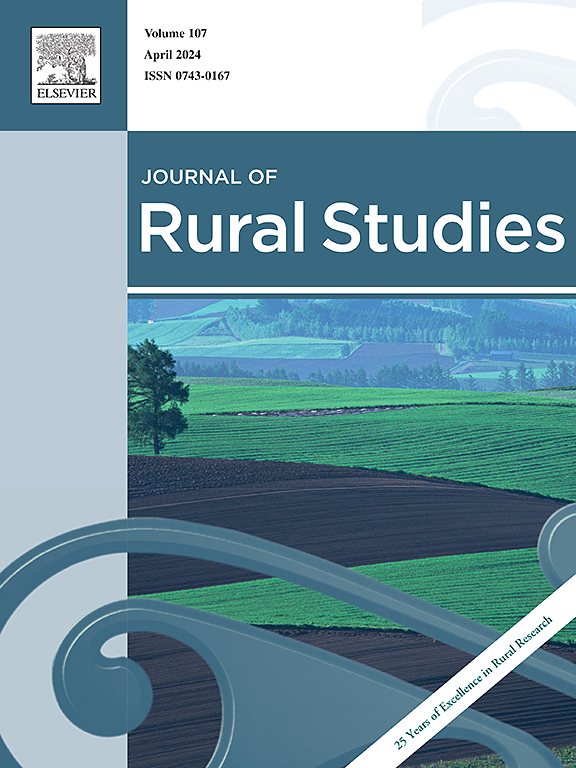Running to stand still? Finding levers to address population shrinking in the Northern Territory of Australia
IF 5.1
1区 社会学
Q1 GEOGRAPHY
引用次数: 0
Abstract
Population shrinkage in rural Europe has echoes with demographic trends in Northern Australia, where some areas have experienced low growth or shrinkage for around a decade due to negative internal migration outcomes. Despite targeted policies to stimulate long-term growth, regions in Northern Australia struggle to attract and retain the ‘right’ sort of populations. Emblematic of this, the Northern Territory, Australia's most sparsely settled jurisdiction, had 32 successive quarters of negative internal migration leading up to the COVID pandemic and exchanges a fifth of its population each year through migration, births and deaths. It imports large numbers of early-career aged workers, most of whom leave in their 30s or early 40s. Constant inflows of new residents with a considerable risk of near-future out-migration sees the population ‘Running to stand still,’ with upticks in jobs and economic activity leading to future poor migration outcomes. Governments are interested in economic levers for internal migration and in this study, we analyse long-term data for key macroeconomic variables for the Northern Territory to ascertain their significance as leading correlates for improved net interstate migration. We find residential property prices are most significant but, against perceptions, jobs vacancies do not positively influence internal migration outcomes. The results emphasises the Northern Territory Government's limited volition to turn-around migration through its own macroeconomic settings, leaving it subject to external conditions. Constraints in economic levers mean other facets for attraction and retention, such as qualitative elements like quality education, lifestyle facilities, enhancing social networks and promoting the Territory as a place for multi-residence workers or retirees need to be considered in developing a holistic approach to population stagnation.
跑着站着不动?寻找解决澳大利亚北领地人口萎缩问题的手段
欧洲农村人口的萎缩与北澳大利亚的人口趋势相呼应,由于负面的内部移民结果,一些地区在大约十年的时间里经历了低增长或萎缩。尽管有针对性的政策来刺激长期增长,但澳大利亚北部地区仍在努力吸引和留住“合适”的人口。最具代表性的是,澳大利亚人口最稀少的司法管辖区北领地在新冠疫情爆发前连续32个季度出现了内部移民负增长,每年有五分之一的人口通过移民、出生和死亡进行交换。中国进口了大量处于职业生涯初期的工人,其中大多数人在30多岁或40岁出头就离开了中国。不断涌入的新居民在不久的将来有很大的外迁风险,这使得人口“趋于停滞”,而就业和经济活动的增加将导致未来糟糕的移民结果。政府对国内移民的经济杠杆感兴趣,在本研究中,我们分析了北领地关键宏观经济变量的长期数据,以确定它们作为改善净州际移民的主要相关因素的重要性。我们发现住宅房地产价格是最重要的,但与人们的看法相反,职位空缺对国内移民结果没有积极影响。结果强调了北领地政府通过其自身的宏观经济设置扭转移民的有限意愿,使其受制于外部条件。经济杠杆方面的限制意味着在制定解决人口停滞问题的整体办法时,需要考虑吸引和保留的其他方面,例如质量因素,如优质教育、生活方式设施、加强社会网络和促进领土成为多居工人或退休人员的地方。
本文章由计算机程序翻译,如有差异,请以英文原文为准。
求助全文
约1分钟内获得全文
求助全文
来源期刊

Journal of Rural Studies
Multiple-
CiteScore
9.80
自引率
9.80%
发文量
286
期刊介绍:
The Journal of Rural Studies publishes research articles relating to such rural issues as society, demography, housing, employment, transport, services, land-use, recreation, agriculture and conservation. The focus is on those areas encompassing extensive land-use, with small-scale and diffuse settlement patterns and communities linked into the surrounding landscape and milieux. Particular emphasis will be given to aspects of planning policy and management. The journal is international and interdisciplinary in scope and content.
 求助内容:
求助内容: 应助结果提醒方式:
应助结果提醒方式:


